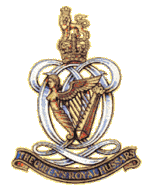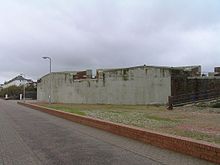Queen's Royal Hussars
| The Queen's Royal Hussars (The Queen's Own and Royal Irish) | |
|---|---|
 Cap Badge of The Queen's Royal Hussars | |
| Active | 2 September 1993- |
| Country | United Kingdom |
| Branch | Army |
| Type | Line Cavalry |
| Role | Armoured |
| Size | One regiment |
| Part of | Royal Armoured Corps |
| Garrison/HQ | RHQ - London Regiment - Sennelager, Germany |
| Nickname(s) | "St Georges Crossbelts" |
| March | Quick - Regimental Quick March of The Queen's Royal Hussars Slow - 3rd Hussars Slow March/ Litany of Loretto/The Garb of Old Gaul/March of the Scottish Archers |
| Mascot(s) | Drum Horse (Winston) |
| Commanders | |
| Colonel-in-Chief | HRH The Duke of Edinburgh, KG, KT, GBE |
| Colonel of the Regiment | Major-General Arthur George Denaro CBE |
| Notable commanders | Winston Churchill |
| Insignia | |
| Tactical Recognition Flash | File:QRH TRF.PNG |
| Arm Badge | Coat of Arms of City of Warsaw from 7th Hussars |
| Tartan | Saffron (Pipers kilts and capes) |
| Abbreviation | QRH |
The Queen's Royal Hussars (The Queen's Own and Royal Irish) (QRH) is the senior United Kingdom light cavalry regiment. It was formed on 1 September 1993 from the amalgamation of The Queen's Own Hussars and The Queen's Royal Irish Hussars. The regiment traces its roots back to 1685 and during the past 320 years has been awarded 172 Battle Honours and 8 Victoria Crosses including:
History
The Queen's Royal Hussars was formed in Fallingbostel on 1 September 1993 from the amalgamation of The Queen's Own Hussars and The Queen's Royal Irish Hussars.
After moving to Catterick in June 1995, the regiment, in January 1996, became the first to be deployed in Challenger 1 tanks to Bosnia with NATO's British-led Implementation Force IFOR. It spent its time as part of 2nd Canadian Multi National Brigade, and was awarded The Canadian Forces Unit Commendation - the first time that this had been awarded to a foreign unit, and the first overseas commendation received by a British unit since the Korean War. The following year, 1997, the regiment was deployed in the dismounted role to Northern Ireland. The regiment subsequently converted to Challenger 2 tanks, in which an independent tank squadron deployed to Kosovo in 2001, with the entire regiment deploying later that year in the dismounted role.
The regiment is currently based in Sennelager, Germany, where it is the armoured regiment for 20th Armoured Brigade, part of British Forces Germany. The regiment returned at the end of November 2006 from a successful deployment in Iraq on Operation Telic 8.
Organisation
The regiment is a Type 58 Challenger 2 tank regiment (ie: it is equipped with 58 Challenger 2 tanks), which are organised into four Sabre Squadrons.
In addition the regiment also fields a close reconnaissance troop mounted in eight CVRT Scimitar, and a large Headquarters Squadron, which supplies ammunition, fuel, and rations and includes specialist technicians, mechanics and artisans, as well as clerical and medical staff.
Museums
The regiment has two museums in England:
- The Queen's Own Hussars Museum is located at Lord Leycester Hospital in Warwick.
- The Queen's Royal Irish Hussars Museum is located at The Redoubt Fortress in Eastbourne.
The Regimental Crest & Cap Badge
- The Regimental Crest is made up from the Angel Harp of the 8th Hussars and the Queen's Royal Irish Hussars, which is placed above the White Horse of Hanover of the 3rd Hussars and the Queen's Own Hussars. These are encircled by the Garter Belt, above which is placed the Queen's Crown.
- The Regimental Cap Badge is made up from the Angel Harp of the 8th Hussars and the Queen's Royal Irish Hussars, superimposed on the Regimental cypher of the Queen's Own Hussars, originally bestowed on the 7th Hussars in 1727; the whole is surmounted by the Queen's crown and a lion, with a scroll underneath giving the Regiment's title in blue and gold.
Privileges & Traditions
In over 300 years of distinguished service the Regiment has gained a number of unique privileges and traditions.
Regimental Colours
- Garter Blue: The primary colour of the Regiment is garter blue. This dates from 1685 when The Queen Consort's Regiment of Dragoons, later the 3rd Hussars, wore the Queen's livery with Garter Blue feathered hats. It has been in continuous use ever since.
- Green: The use of green dates from 1748 when it was the facing colour of Princess Anne of Denmark's Regiment of Dragoons, later the 4th Hussars. It is also always associated with Ireland, which remains one of the Regiment's primary recruiting areas. All ranks wear green jumpers and berets, and Officers can be distinguished by their distinctive tent hats (the only item of army headress worn without a cap badge other than with combat uniforms).
- Yellow: The traditional Light Cavalry colour is yellow, which has been used by all of the Regiments predecessors.
The White Horse of Hanover: Ranking second, after the Crown, among the Regiment's military badges, it was bestowed by the first three King Georges to certain regiments for the their part in suppressing the Jacobites. It was first granted, as a special head-dress badge, by King George I to the 3rd King's Own Regiment of Dragoons in 1715 for their part in defeating James Francis Edward Stuart (The Old Pretender).
Crossbelts: At the Battle of Almenar in 1710 the 4th Dragoons pursued the Spanish Cavalry Corps and, equipping themselves with the crossbelts of the enemy, cut down the Spaniards with their own swords. The crossbelts were worn with distinction for many years, and the nickname 'St Georges Crossbelts' was given to the Regiment. Although the crossbelt worn today is based on the original 4th Hussar pattern, the continuing tradition of titling the Regimental Journal 'The Crossbelts' is in recognition of this famous action, as is its use as the nickname for the regimental Polo Team.
The Loyal Toast: After the Jacobite rebellion in 1745, all officers of the army were required to drink the health of the Sovereign in their mess after dinner as a token of loyalty to the King. The King, however, absolved the Regiment from this duty, saying that their loyalty had always been beyond question, and gave the Officers the privilege of never drinking the Loyal Toast in the Officers' Mess and of ignoring the National Anthem when it is played by the band after dinner. This privilege was reaffirmed by the Sovereign prior to the formation of the Regiment in 1993.


Winston Churchill: Winston Churchill, who has been justly described as 'the greatest Hussar of them all', was commissioned into the 4th Hussars in 1895, and later became the Colonel of the Regiment from 1941, remaining so until his death in 1965. In recognition of this, The Churchill Cup is awarded to the top-scoring troop in the Regiment's annual gunnery competition. The Commanding Officer's tank is also named 'Churchill'.
The Maid of Warsaw: Every member of the Regiment wears the Maid of Warsaw, the crest of the City of Warsaw, on the left sleeve of his No. 2 (Service) Dress. This honour was awarded to the 7th Hussars by the Commander of the Second Polish Corps in recognition of their valour in support of the Polish Forces during the Italian Campaign in World War II. Traditionally the original crest presented to the Regiment is placed in front of the Commanding Officer on Dinner Nights.
The Fern Leaf: All vehicles in the Regiment display the emblem of New Zealand, the Fern Leaf, to commemorate the association of the 3rd Hussars with the 2nd New Zealand Division at the Battle of El Alamein. This honour was granted by General Lord Freyburg VC.
Kettle Drums: By command of King George II the silver kettle drums captured by The King's Own Regiment of Dragoons, later the 3rd Hussars, at Dettingen are borne by a drum horse ridden by a Sergeant Kettledrummer - both being additional to the Regimental establishment. The Drums are always carried at the head of the Regiment on ceremonial parades and are, uniquely amongst cavalry regiments, never covered by drum banners, the Battle Honours being engraved directly onto the sides of the drums. In 1772 when Lord Southampton commanded the Regiment, his wife gave a silver collar to be worn by the Kettledrummer, which is still worn today when parading in full dress with the Drums. The present drum horse, Winston, was presented by Her Majesty Queen Elizabeth the Queen Mother.
REGIMENTAL DAYS: The following are celebrated as battle honour days:
St Patrick's Day is also celebrated.
Alliances
Commonwealth
 Canada - The Sherbrooke Hussars
Canada - The Sherbrooke Hussars Canada - Royal Canadian Hussars
Canada - Royal Canadian Hussars Canada - 8th Canadian Hussars (Princess Louise's)
Canada - 8th Canadian Hussars (Princess Louise's) Australia - 2nd/14th Light Horse Regiment (Queensland Mounted Infantry)
Australia - 2nd/14th Light Horse Regiment (Queensland Mounted Infantry) Australia - 3rd/9th Light Horse Regiment (South Australian Mounted Rifles)
Australia - 3rd/9th Light Horse Regiment (South Australian Mounted Rifles) Australia - 4th/19th Prince of Wales Light Horse Regiment
Australia - 4th/19th Prince of Wales Light Horse Regiment Australia - 3rd Battalion, Royal Australian Regiment
Australia - 3rd Battalion, Royal Australian Regiment New Zealand - Queen Alexandra's Mounted Rifles
New Zealand - Queen Alexandra's Mounted Rifles South Africa - Natal Mounted Rifles
South Africa - Natal Mounted Rifles South Africa - Umvoti Mounted Rifles
South Africa - Umvoti Mounted Rifles South Africa - The Light Horse Regiment
South Africa - The Light Horse Regiment
Non-Commonwealth
 Belgium - 2/4 Regiment Lansiers
Belgium - 2/4 Regiment Lansiers France - 7eme Regiment de Chasseurs
France - 7eme Regiment de Chasseurs
Affiliated Yeomanry
Order of Precedence
Links


